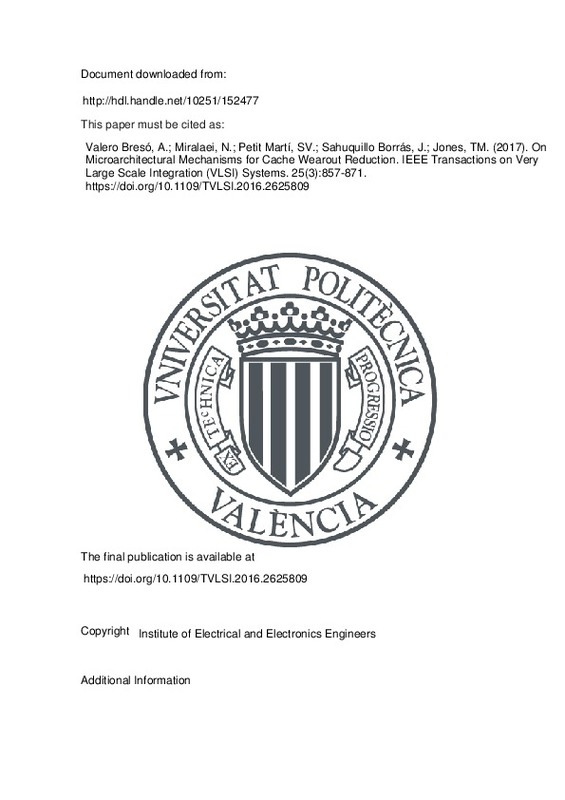JavaScript is disabled for your browser. Some features of this site may not work without it.
Buscar en RiuNet
Listar
Mi cuenta
Estadísticas
Ayuda RiuNet
Admin. UPV
On Microarchitectural Mechanisms for Cache Wearout Reduction
Mostrar el registro sencillo del ítem
Ficheros en el ítem
| dc.contributor.author | Valero Bresó, Alejandro
|
es_ES |
| dc.contributor.author | Miralaei, Negar
|
es_ES |
| dc.contributor.author | Petit Martí, Salvador Vicente
|
es_ES |
| dc.contributor.author | Sahuquillo Borrás, Julio
|
es_ES |
| dc.contributor.author | Jones, Timothy M.
|
es_ES |
| dc.date.accessioned | 2020-10-20T03:31:09Z | |
| dc.date.available | 2020-10-20T03:31:09Z | |
| dc.date.issued | 2017-03 | es_ES |
| dc.identifier.issn | 1063-8210 | es_ES |
| dc.identifier.uri | http://hdl.handle.net/10251/152477 | |
| dc.description.abstract | [EN] Hot carrier injection (HCI) and bias temperature instability (BTI) are two of the main deleterious effects that increase a transistor's threshold voltage over the lifetime of a microprocessor. This voltage degradation causes slower transistor switching and eventually can result in faulty operation. HCI manifests itself when transistors switch from logic "0" to "1" and vice versa, whereas BTI is the result of a transistor maintaining the same logic value for an extended period of time. These failure mechanisms are especially acute in those transistors used to implement the SRAM cells of first-level (L1) caches, which are frequently accessed, so they are critical to performance, and they are continuously aging. This paper focuses on microarchitectural solutions to reduce transistor aging effects induced by both HCI and BTI in the data array of L1 data caches. First, we show that the majority of cell flips are concentrated in a small number of specific bits within each data word. In addition, we also build upon the previous studies, showing that logic "0" is the most frequently written value in a cache by identifying which cells hold a given logic value for a significant amount of time. Based on these observations, this paper introduces a number of architectural techniques that spread the number of flips evenly across memory cells and reduce the amount of time that logic "0" values are stored in the cells by switching OFF specific data bytes. Experimental results show that the threshold voltage degradation savings range from 21.8% to 44.3% depending on the application. | es_ES |
| dc.description.sponsorship | This work was supported in part by the Spanish Ministerio de Economia y Competitividad within the Plan E Funds under Grant TIN2015-66972-C5-1-R, in part by the HiPEAC Collaboration Grant funded by the FP7 HiPEAC Network of Excellence under Grant 287759, and in part by the Engineering and Physical Sciences Research Council under Grant EP/K026399/1 and Grant EP/J016284/1. | es_ES |
| dc.language | Inglés | es_ES |
| dc.publisher | Institute of Electrical and Electronics Engineers | es_ES |
| dc.relation.ispartof | IEEE Transactions on Very Large Scale Integration (VLSI) Systems | es_ES |
| dc.rights | Reserva de todos los derechos | es_ES |
| dc.subject | Bias temperature instability (BTI) | es_ES |
| dc.subject | Cache memories | es_ES |
| dc.subject | Cell flips | es_ES |
| dc.subject | Duty cycle distribution | es_ES |
| dc.subject | Hot carrier injection (HCI) | es_ES |
| dc.subject | Threshold voltage degradation | es_ES |
| dc.subject.classification | ARQUITECTURA Y TECNOLOGIA DE COMPUTADORES | es_ES |
| dc.title | On Microarchitectural Mechanisms for Cache Wearout Reduction | es_ES |
| dc.type | Artículo | es_ES |
| dc.identifier.doi | 10.1109/TVLSI.2016.2625809 | es_ES |
| dc.relation.projectID | info:eu-repo/grantAgreement/EC/FP7/287759/EU/High Performance and Embedded Architecture and Compilation/ | es_ES |
| dc.relation.projectID | info:eu-repo/grantAgreement/UKRI//EP%2FJ016284%2F1/GB/DOME: Delaying and Overcoming Microprocessor Errors/ | es_ES |
| dc.relation.projectID | info:eu-repo/grantAgreement/UKRI//EP%2FK026399%2F1/GB/M3: Managing Many-Cores for the Masses/ | es_ES |
| dc.relation.projectID | info:eu-repo/grantAgreement/MINECO//TIN2015-66972-C5-1-R/ES/TECNICAS PARA LA MEJORA DE LAS PRESTACIONES, COSTE Y CONSUMO DE ENERGIA DE LOS SERVIDORES/ | es_ES |
| dc.rights.accessRights | Abierto | es_ES |
| dc.contributor.affiliation | Universitat Politècnica de València. Departamento de Informática de Sistemas y Computadores - Departament d'Informàtica de Sistemes i Computadors | es_ES |
| dc.description.bibliographicCitation | Valero Bresó, A.; Miralaei, N.; Petit Martí, SV.; Sahuquillo Borrás, J.; Jones, TM. (2017). On Microarchitectural Mechanisms for Cache Wearout Reduction. IEEE Transactions on Very Large Scale Integration (VLSI) Systems. 25(3):857-871. https://doi.org/10.1109/TVLSI.2016.2625809 | es_ES |
| dc.description.accrualMethod | S | es_ES |
| dc.relation.publisherversion | https://doi.org/10.1109/TVLSI.2016.2625809 | es_ES |
| dc.description.upvformatpinicio | 857 | es_ES |
| dc.description.upvformatpfin | 871 | es_ES |
| dc.type.version | info:eu-repo/semantics/publishedVersion | es_ES |
| dc.description.volume | 25 | es_ES |
| dc.description.issue | 3 | es_ES |
| dc.relation.pasarela | S\359063 | es_ES |
| dc.contributor.funder | UK Research and Innovation | es_ES |
| dc.contributor.funder | Engineering and Physical Sciences Research Council, Reino Unido | es_ES |
| dc.contributor.funder | Ministerio de Economía y Competitividad | es_ES |







![[Cerrado]](/themes/UPV/images/candado.png)

